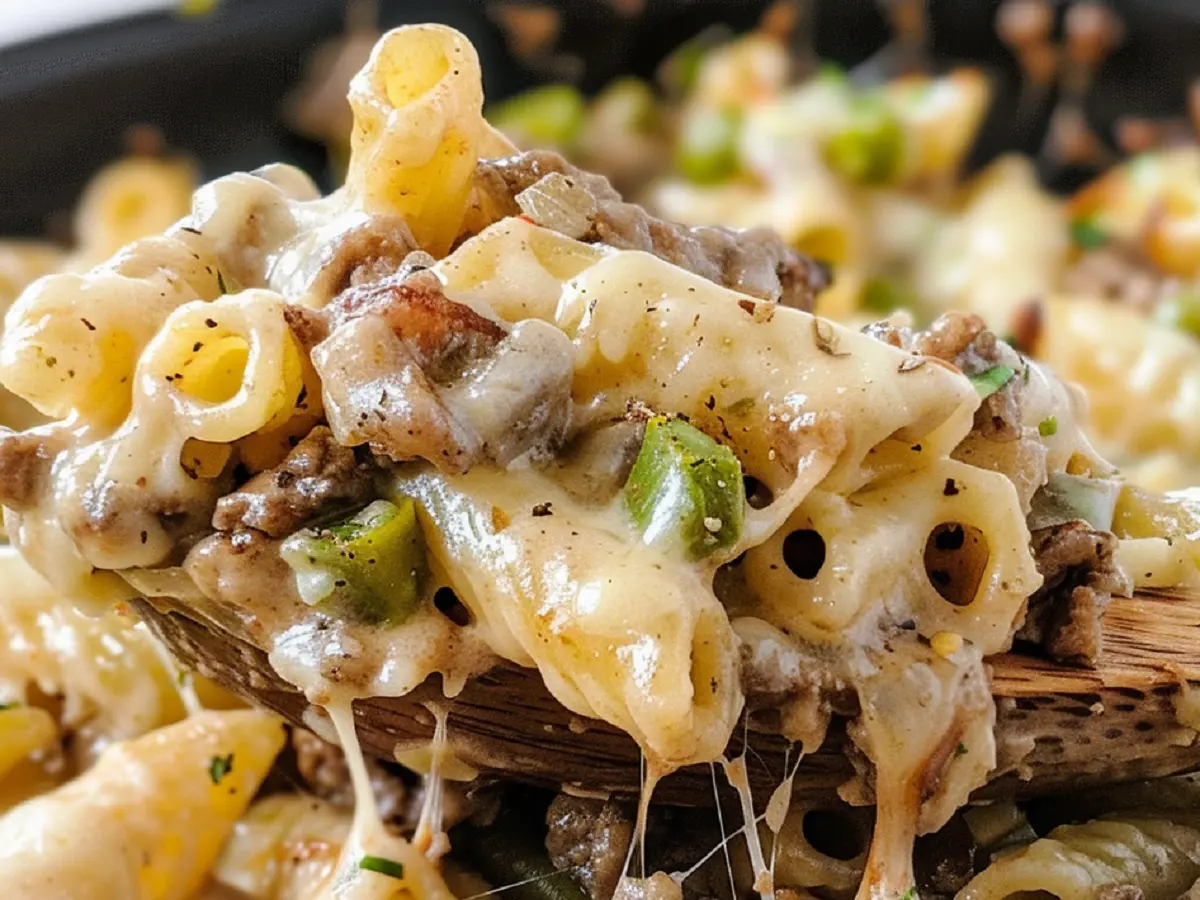Introduction
Philly cheesesteaks are a beloved staple in American cuisine, known for their juicy steak and melty cheese tucked into a hearty bun. Today, we explore an exciting variation: the Classic Philly Cheesesteak Pasta. This dish blends the traditional flavors of a Philly cheesesteak with the comfort of a creamy pasta, making it a perfect meal for any day of the week.
The Ingredients
Each component of this dish plays a pivotal role in mimicking the classic Philly cheesesteak flavors while adding a creamy pasta twist. From the al dente penne capturing the sauce to the thinly sliced beef steak offering that authentic cheesesteak experience, every ingredient matters. Here’s what you’ll need:
- 8 ounces of pasta (like penne or fusilli)
- 1 tablespoon olive oil
- 1 pound thinly sliced beef steak
- 1 green bell pepper, sliced
- 1 onion, thinly sliced
- 2 cloves garlic, minced
- 1 cup sliced mushrooms
- 1/2 teaspoon salt
- 1/4 teaspoon black pepper
- 2 tablespoons Worcestershire sauce
- 1 cup beef broth
- 1 cup heavy cream
- 1 cup shredded provolone cheese
Step-by-Step Cooking Guide
Preparation of Pasta
Start by cooking the pasta as per the package instructions until it’s just al dente. Drain and set aside, making sure to keep some pasta water for adjusting the sauce consistency later.
Cooking the Steak
Heat olive oil in a large skillet over medium-high heat. Season the steak slices with salt and pepper, and sear until browned. Set aside to keep them tender.
Sautéing the Vegetables
In the same skillet, add the sliced vegetables. Cook until they are just softened, then stir in minced garlic to release its aroma without burning.
Creating the Sauce
Pour in Worcestershire sauce, beef broth, and heavy cream into the skillet with vegetables. Bring to a simmer, then reduce the heat and reintegrate the pasta and steak. Allow the dish to warm through thoroughly, ensuring the flavors meld.
Tips for Perfecting the Dish
Selecting the Right Cut of Beef
The choice of beef is crucial for achieving the perfect Philly Cheesesteak Pasta. Opt for ribeye or sirloin for the best results; these cuts are flavorful and tender, making them ideal for quick searing.
Cheese Variations for Different Tastes
Provolone cheese is traditional, but don’t hesitate to experiment with other types. Smoked gouda can add a rich depth, while a mild mozzarella offers a more subdued flavor that lets the beef shine.
Nutritional Information
This dish offers a robust array of nutrients. Beef provides high-quality protein and iron, while mushrooms add essential minerals and vitamins. Here’s a closer look:
- Calories: Approximately 620 kcal per serving
- Protein: Essential for muscle repair and growth
- Carbohydrates: Provides energy through pasta
- Fats: Healthy fats from olive oil and cream contribute to satiety
Serving Suggestions
Best Sides to Complement Philly Cheesesteak Pasta
A simple arugula salad dressed with lemon and olive oil or steamed green beans makes for a light, refreshing side that balances the richness of the pasta.
Wine Pairing Ideas
A medium-bodied red wine, such as a Merlot or a young Chianti, pairs wonderfully with the savory components of the cheesesteak pasta.
Adapting for Dietary Restrictions
Gluten-Free Alternatives
Switch traditional pasta for a gluten-free variety made from rice or quinoa. Ensure that the Worcestershire sauce and beef broth are labeled gluten-free.
Vegan and Vegetarian Adaptations
For a vegetarian version, replace the beef with portobello mushrooms, which provide a similar meaty texture. Use vegan cheese and a plant-based cream to cater to vegan diets.
The History of Philly Cheesesteak
The Philly cheesesteak originated in the early 20th century in Philadelphia. It has since become an iconic American sandwich, known for its simplicity and deliciousness, which inspired this pasta variant.
Culinary Techniques Highlighted
Importance of Slicing Beef Thinly
Thin slicing is key to ensuring the beef cooks quickly and remains tender. Freeze the beef slightly to make slicing easier.
Tips for a Creamy Sauce
Maintain a gentle simmer when adding the cream to prevent it from curdling. Stirring constantly helps to create a smooth, velvety sauce.
Kids and Philly Cheesesteak Pasta
Making it Kid-Friendly
Reduce the onions and green peppers for children who prefer milder flavors. Adding a bit of extra cheese can make the dish more appealing to young palates.
Adjustments for Milder Flavors
Substitute green bell peppers with red or yellow ones, which are sweeter and less intense, making the dish more kid-friendly.
Storing and Reheating
Best Practices for Storing Leftovers
Cool the pasta completely before storing it in an airtight container in the refrigerator. It will keep for up to three days.
How to Reheat for Best Taste
Reheat on the stove over low heat, adding a splash of beef broth or cream to loosen the sauce and restore its creamy texture.
Testimonials and Reviews
“I never knew combining Philly cheesesteak with pasta could taste so amazing! It’s now a staple in our family dinners.” — Sarah L.
“My kids loved it, and they’re asking for it again this weekend!” — Mike D.
Conclusion
This Philly Cheesesteak Pasta merges two iconic comfort foods into one delightful dish. It’s creamy, it’s cheesy, and it’s packed with the authentic flavors of a Philly cheesesteak, all wrapped up in a comforting pasta meal.
FAQs
- Can I use chicken instead of beef? Yes, chicken is a great substitute for a lighter version of this dish.
- What other cheeses can I use? While provolone is traditional, feel free to experiment with mozzarella or cheddar for different flavors.
- How can I make this dish gluten-free? Opt for gluten-free pasta and ensure all other ingredients are certified gluten-free.
- Is there a way to make this dairy-free? Yes, use dairy-free cheese alternatives and swap out the heavy cream for a plant-based cream.
- Can I prepare this dish ahead of time? Yes, this dish can be prepped ahead and reheated, making it perfect for busy weeknights.



